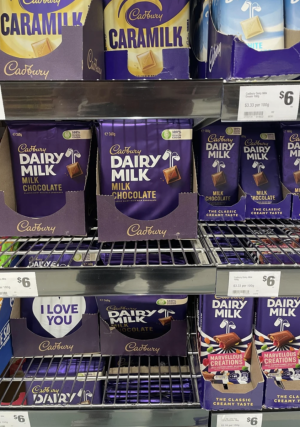Outrage over Price Detail Spotted by Woolworths Shoppers in Cadbury Product!
By
- Replies 11
Shoppers around Australia are outraged after noticing a shocking and seemingly inexplicable detail in Cadbury Dairy Milk chocolate products at Woolworths supermarkets.
Eagle-eyed customers recently spotted that 360g blocks of various Cadbury chocolate bars were being sold at the exact same price as 180g blocks of the same bar, despite the 2x difference in size. Images shared on social media showed two blocks of Cadbury Dairy Milk chocolate - one 360g and the other 180g - sitting side-by-side on the shelves with identical $6 price tags.
With food prices and inflation continuing to skyrocket in Australia, consumers are growing increasingly frustrated with bizarre pricing strategies like this that seemingly defy basic logic.
'It makes absolutely no sense. The smaller block is clearly double the price per 100g so there's no reason they should cost the same,' fumed one angry shopper on social media site Reddit. Several others chimed in, agreeing it was 'insane' while some vowed to boycott Woolworths over the seemingly arbitrary pricing.
'That's the problem with the world today – junk food is cheaper than healthy food. The supermarkets are profiting off making Australia sick,' one health-conscious consumer said.
This strange pricing technique seems purposefully designed to trick shoppers into buying the smaller size thinking they're getting a better deal. But upon closer inspection, the per unit price exposes it as false advertising.
Some commenters speculated Cadbury plans to soon raise the price of the 360g blocks to $9 or $10 based on the smaller blocks already being priced equivalently. One video highlighting the pricing issue quipped, “Supermarket maths is calling this 'customer savings' - are they joking?”
This is far from the first time eagle-eyed shoppers have called out curious pricing tactics for different products at Woolworths and other major Aussie supermarket chains.
Many have pointed to different soft drink bottle sizes with identical pricing regardless of volume, with the bigger sizes presented as 'better value'. 'It's a tactic to get us to buy more than we need. The supermarkets are preying on consumer psychology,' behavioural economist Dr Eliza Brown explained.
Cadbury has so far remained silent despite the growing backlash from increasingly fed-up consumers. Some analysts say the issue highlights the broader problems of soaring cost of living and inflation while big corporations continue reaping record profits.
'It's getting impossible for average families to afford even basic groceries while the supermarkets and food giants rake in billions. Something has to change,' remarked consumer advocate Tom Smith.
A deep dive into supermarket pricing strategies reveals some peculiar tactics applied by these retail giants. As mentioned above, these tactics often play on consumer psychology, making customers believe they are getting a better deal when they're not.
Typically, supermarkets use a subtle marketing strategy known as ‘charm pricing’. This method involves reducing the price of the product by a small amount to make it appear significantly cheaper. For example, pricing an item at $4.99 instead of an even $5. However, in the case of Woolworths' Cadbury pricing strategy, it appears a more confusing approach has been taken, leaving customers baffled rather than charmed.
Additionally, supermarkets often strategically arrange products to manipulate purchasing habits. Higher margin products or items which bring in the greatest profit, are usually placed at eye-level. Conversely, lesser priced goods are placed on lower or higher shelves where they're less likely to catch attention. This layout trick, combined with inconsistent pricing strategies, only confuse shoppers further and leads to a feeling of deception.

The situation with Cadbury products at Woolworths holds up a mirror to the often convoluted and perplexing world of supermarket pricing strategies. It brings to light whether maintaining such puzzling approaches towards pricing is justifiable and raises the question of whether clearer, more transparent pricing policies should be enforced to ensure fair trading and consumer trust.
As consumers become more observing and voice their concerns openly, supermarkets may have to rethink their approach. Have you noticed any other weird pricing at the supermarket lately? Let us know in the comments!
Eagle-eyed customers recently spotted that 360g blocks of various Cadbury chocolate bars were being sold at the exact same price as 180g blocks of the same bar, despite the 2x difference in size. Images shared on social media showed two blocks of Cadbury Dairy Milk chocolate - one 360g and the other 180g - sitting side-by-side on the shelves with identical $6 price tags.
With food prices and inflation continuing to skyrocket in Australia, consumers are growing increasingly frustrated with bizarre pricing strategies like this that seemingly defy basic logic.
'It makes absolutely no sense. The smaller block is clearly double the price per 100g so there's no reason they should cost the same,' fumed one angry shopper on social media site Reddit. Several others chimed in, agreeing it was 'insane' while some vowed to boycott Woolworths over the seemingly arbitrary pricing.
'That's the problem with the world today – junk food is cheaper than healthy food. The supermarkets are profiting off making Australia sick,' one health-conscious consumer said.
This strange pricing technique seems purposefully designed to trick shoppers into buying the smaller size thinking they're getting a better deal. But upon closer inspection, the per unit price exposes it as false advertising.
Some commenters speculated Cadbury plans to soon raise the price of the 360g blocks to $9 or $10 based on the smaller blocks already being priced equivalently. One video highlighting the pricing issue quipped, “Supermarket maths is calling this 'customer savings' - are they joking?”
This is far from the first time eagle-eyed shoppers have called out curious pricing tactics for different products at Woolworths and other major Aussie supermarket chains.
Many have pointed to different soft drink bottle sizes with identical pricing regardless of volume, with the bigger sizes presented as 'better value'. 'It's a tactic to get us to buy more than we need. The supermarkets are preying on consumer psychology,' behavioural economist Dr Eliza Brown explained.
Cadbury has so far remained silent despite the growing backlash from increasingly fed-up consumers. Some analysts say the issue highlights the broader problems of soaring cost of living and inflation while big corporations continue reaping record profits.
'It's getting impossible for average families to afford even basic groceries while the supermarkets and food giants rake in billions. Something has to change,' remarked consumer advocate Tom Smith.
A deep dive into supermarket pricing strategies reveals some peculiar tactics applied by these retail giants. As mentioned above, these tactics often play on consumer psychology, making customers believe they are getting a better deal when they're not.
Typically, supermarkets use a subtle marketing strategy known as ‘charm pricing’. This method involves reducing the price of the product by a small amount to make it appear significantly cheaper. For example, pricing an item at $4.99 instead of an even $5. However, in the case of Woolworths' Cadbury pricing strategy, it appears a more confusing approach has been taken, leaving customers baffled rather than charmed.
Additionally, supermarkets often strategically arrange products to manipulate purchasing habits. Higher margin products or items which bring in the greatest profit, are usually placed at eye-level. Conversely, lesser priced goods are placed on lower or higher shelves where they're less likely to catch attention. This layout trick, combined with inconsistent pricing strategies, only confuse shoppers further and leads to a feeling of deception.
Key Takeaways
- Woolworths customers have noticed that 360g blocks of Cadbury Dairy Milk chocolate are the same price as 180g blocks.
- Social media users shared posts highlighting the apparent pricing discrepancy and speculated on the motives behind it.
- A Mondelez Australia spokesperson said that pricing was set by retailers, suggesting Woolworths made the decision.
- Many social media users criticised the pricing strategy, arguing that it seemed illogical and highlighted broader issues with food pricing.
The situation with Cadbury products at Woolworths holds up a mirror to the often convoluted and perplexing world of supermarket pricing strategies. It brings to light whether maintaining such puzzling approaches towards pricing is justifiable and raises the question of whether clearer, more transparent pricing policies should be enforced to ensure fair trading and consumer trust.
As consumers become more observing and voice their concerns openly, supermarkets may have to rethink their approach. Have you noticed any other weird pricing at the supermarket lately? Let us know in the comments!








